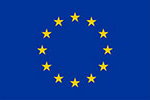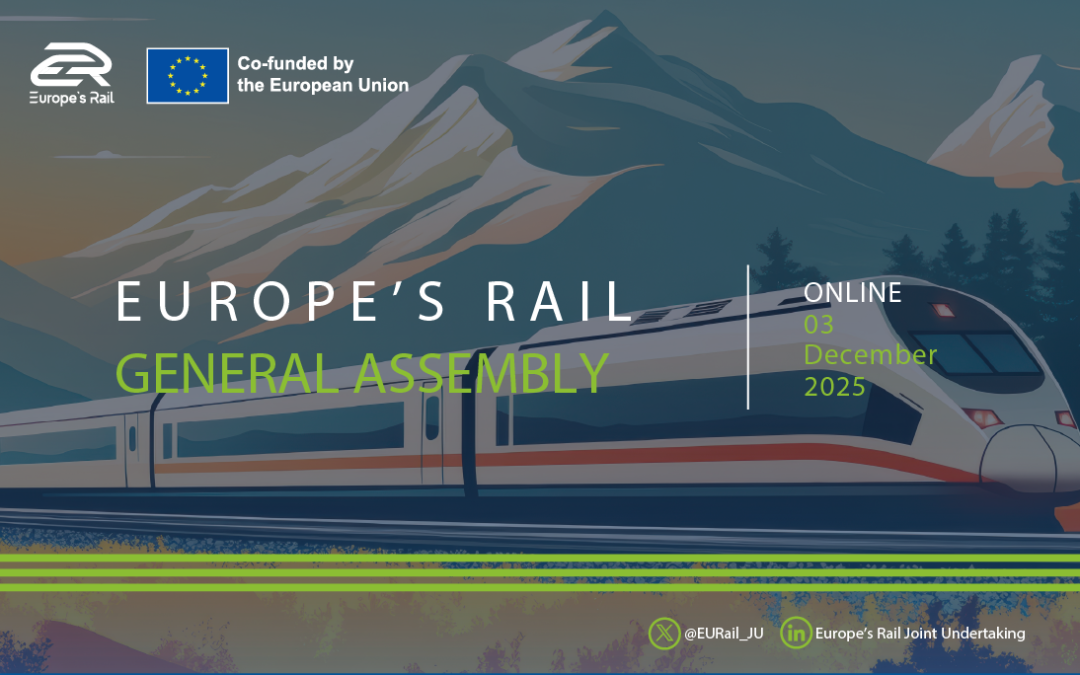Among the nine major Flagship Projects (FPs) funded by Europe’s Rail Joint Undertaking (EU-Rail), FP2-R2DATO plays a...
Deliverables published by the project
D4.4 – SWOC LX Solution for Multimodality Report
The primary objectives of D4.4 are to outline a set of requirements and architectures that reflect the operational and functional behaviour when deployed at Regional Lines for:
1 – Smart Wayside Object Controller (SWOC) Multi Modal Level Crossing (MMLX) top functionality for G1 and G2 lines.
2 – SWOC MMLX Business model study.
3 – SWOC MMLX Use cases. These use cases are also applicable to task 4.2.
In addition to specifying requirements, D4.4 parts (documents) also include analysis and investigations of new interfaces and business cases.
This document provides sections describing the process used to derive (a) the architecture from the requirements, (b) the requirements from the Use Cases and (c) it also describes how the requirements are managed.
The linked parts (documents) discuss the social-economic benefits targeted by the requirements and architecture specifications. FP6 FutuRe project has accepted the lack of cost baselines from infrastructure managers, thus D4.4 cost reduction proposals may need to be verified in the future.
D4.2 – Requirement specifications for Communication Report
The primary objective of D4.2 is to outline a set of requirements and architectures that reflect the operational and functional behavior of:
1 – The external wireless interfaces of D4.4 Smart Wayside Object Controller (SWOC) Multi Modal Level Crossing (MMLX).
2 – The trackside-trackside and trackside-field devices wireless communications in general.
In addition to specifying requirements, D4.2 parts (documents) also include analysis and investigations of new direct wireless communication trackside to train in the context of SWOC MMLX.
This document also provides sections describing the process used to derive (a) the architecture from the requirements, (b) the requirements from the Use Cases and (c) it also describes how the requirements are managed.
The linked parts (documents) discuss the social-economic benefits targeted by the requirements and architecture specifications. FP6 FutuRe project has accepted the lack of cost baselines from infrastructure managers, thus D4.2 cost reduction proposals may need to be verified in the future. It is highly recommended to read this delivery in conjunction with D4.4. Both deliveries are deeply interconnected and they complement each other. The formal links between D4.2 and D4.4 are presented later in this document in the requirements and documents structure. Specifically, High Level Requirements for Communication interfaces are defined to fit D4.4 context.
D4.3 – Design and architecture specifications for Communications Report
This document, D4.3 Design and architecture specifications for communications, is framed in the Europe’s Rail Joint Undertaking FP6 – FutuRe project, and mainly focuses on designing a modern and adaptable communications architecture for the European railways sector in a context of a technologic transition driven by the obsolescence of GSM-R and other legacy mobile communications systems and the adoption of the new standard FRMCS or cost effective wireless solutions for regional lines. This architecture seeks to optimize both operative costs (OPEX) and capital costs (CAPEX) for the regional lines, while improving network capabilities such as bandwidth, latency, and availability and enable new applications due to these improvements.
The architecture to be developed will improve both operational safety and the efficiency of railway communications, enabling advanced services such as autonomous train operation (ATO), video surveillance and Wi-Fi for passengers.
The development of the architecture follows a methodology structured in phases, according to CENELEC specifications, to ensure that it meets the safety, reliability, and efficiency requirements of the railway environment. The main phases include:
– Concept and system definition phase: This phase focused on identifying the connectivity needs for main and regional lines, and on integrating multiple types of networks, from mobile operators to satellite and dedicated networks.
– Definition of use cases and requirements: Different use cases and the associated requirements were specified to detail the needs of the proposed architecture.
– Definition of architecture and interfaces: The functional blocks of the architecture were specified and the interfaces that link them were identified.
– Definition of the test setup and test scenarios.
D4.1 – Requirement specifications for Wayside Assets Report
The present document represents the Deliverable D4.1 with the title “Requirement Specification for Wayside Assets Report”.
This primary objective of this Deliverable is to outline a set of requirements that reflect the operational and functional behaviour of three specific Wayside Assets when deployed at Regional Lines: Level Crossings, Switches and Obstacle Detection Systems. In addition to specifying these requirements, the document also includes various analysis and developments related to the Wayside Assets.
Before developing the requirements, a series of reference Use Cases were defined to:
• provide a foundation for the development and derivation of the requested requirements,
• serve as a reference for activities planned later in the project in context of demonstrator development (in further WP9).
Additionally, this deliverable encompasses sections that provide context and background of the work. These sections describe the methodology used to derive the requirements from the Use Cases and detail how the requirements are managed. The document also discusses the social-economic benefits targeted by the requirements specification, which are considered achievable through its successful implementation.
D5.1 – State-of-the Art Report for regional lines rolling stock
This deliverable will provide, as specified in the Grant Agreement:
• A comprehensive report on requirement specification for rolling stock with a particular focus on mechanical architecture, mechanical parts, TCMS, traction/propulsion, modular interior, and train control,
• Suggestions on legislative changes/TSI updates (LOC&PAS, CCS, OPE) including operational and functional needs,
• A first concept for a lightweight, emission free rolling stock with modular interior.
D5.2 – Specifications CCS for Group 2
Group 2 Regional Lines (G2 Lines) are lines or network of lines that are not functionally/operationally connected with the mainline network (ER JU Multi Annual Work Programme and Article 1.3 (c) of the EU Interoperability Directive [8]). Group 2 regional rail is operated by passenger and/or freight services that do not enter mainline infrastructure.
G2 Lines approach is completely different from the one considered in Group 1 Regional lines (G2 Lines). While G1 lines are required to ensure interoperability within the European network, G2 lines being free from such requirement allow for a radical new approach which will be described in the document and can be summarized by the following key concepts:
1. Decouple the railway application from the telecommunication technologies.
2. Keep free the system architecture as much as possible avoiding constraining future developments.
3. Data sharing as the mean to ensure standardization and competition.
In this report, we will analyse how the above concepts match European initiatives on Satellite communications and Federated Data Spaces.
Moreover, G2 lines, apart few exceptions, are characterized by very low traffic and consequently can accommodate solutions based on not expensive technologies thanks to the less demanding operations.
D2.3 – FIRST RELEASE OF KPI ACHIEVEMENT
The present document constitutes the Deliverable D2.3 “First release of KPI achievement” in the framework of the Task 2.3 of the WP2 of FP6 – FutuRe project.
This document has the following goals:
• to collect and sort the SEOs and KPIs relevant for the FutuRe project which are reported in several tables of the Grant Agreement and in the Multi Annual Work Plan (chapter 2)
• to define a methodology aiming to measure the achievement of the KPIs once the solutions developed within the project are implemented (chapter 3)
• to define a measurable criterion for each KPI (chapter 4)
• starting from the current state-of-the-art of the solutions under development, to provide a preliminary qualitative justification about the confidence that the solutions under development within the project are going to contribute to the achievement of the KPIs (chapter 5).
Since the main target is to define rules which allow the quantitative measure of the achievement of a KPI by the solutions intended to be developed within the project, the main challenge which has been taken up is the identification of:
• the link between FutuRe items/solutions and the relevant most significant KPIs
• the significant parameters linked to the FutuRe items/solutions and to the KPIs
• the current reference figure for those parameters; such parameters, and their reference figures, define a reference baseline scenario which reflects the current situation not implementing yet the solutions under development within the project
Typically, the measurable criterion is given as the comparison of the values of the parameters before and after the implementation of the innovative solutions.
Chapter 3 reports the description of the reference baseline scenario for both trackside and the vehicle.
Not all FutuRe items/solutions have been considered to provide a measurable contribution to the achievement of the KPIs: for items/solutions which have been excluded, a justification is provided in chapter 3.
This document does not provide the result of the application of the quantitative evaluation criteria to the items/solutions intended to be demonstrated within FutuRe; this is the main target of a second document (or version 2 of the current document) foreseen by Task 2.3 at the end of the project.
This second document will also offer the possibility to adjust/consolidate the value of some reference parameters which, in the current document, have been defined as “educated guess”. Also, the definition of new parameters will be possible provided the relevant quantitative figures are determined.
This document has been edited by RFI having the role of task leader. However, due to its transversal nature, it is the results of the contributions produced by all FutuRe task leaders and the involved experts.
D6.2 – Specification of Multimodal Travel Solution (Final Release)
Regional railways play a crucial role in Europe, not only by serving rural areas but also by acting as feeders
for passenger and freight traffic to the main network. These lines provide an essential, environmentally
friendly mode of transport. When combined with other public or private transportation options—such as
buses, micro-mobility services, on-demand services, cycling, walking, and driving—regional railways enable
passengers to reach remote stations and rural destinations effectively.
Ensuring the long-term viability of regional railways requires high service quality and customer satisfaction,
making rail an attractive and preferred mode of transport. Passengers rely daily on regional trains and
services for their transportation needs. To achieve and enhance customer satisfaction, reliability, and
efficiency, sophisticated information services are key. The societal importance of a smoothly running rail
service lies not only in its role as a critical infrastructure component in many European countries but also
in its contribution to sustainable living, trading, and travel.
Within FP6-FutuRe WP6, a highly accurate multimodal travel solution is developed. The goal is to deliver
transport service information for first and last mile services, while including passenger transportation and
partly combining it with freight transportation. The service information shall be supplied both on-board of
regional vehicles, e.g. via personal digital devices, and at regional rail stations. In rural areas with mostly
low density of rail services, travellers need to be able to proceed with their journey once they have reached
their final railway station.
To cater to this need, this deliverable D6.2 contains a specification of a technical solution to provide
passengers with real-time information on which mode or combination of modes is suitable to reach their
destinations. It is considered that there might be delays or other incidents that affect a transport services’
operating schedule and that some travellers may have specific mobility restrictions. Interfaces between rail
services and other mobility services, such as demand responsive transport, are helpful to adjust to different
scenarios and to operate as efficiently as possible. A possible solution is developed in collaboration of
several tasks within WP6 as well as in exchange with FP1-MOTIONAL.
The present document specifies the Final Release outline of our solution, covering the integration of
Demand Responsive Transport (DRT) in journey planning, and demand-related information for Persons with
Reduced Mobility (PRM). This document continues the initial specification of the Regional Rail Services
solution defined in D6.1, where user stories, use cases, and a high-level list of requirements were identified.
The current document builds on these use cases to derive a detailed list of requirements, sequence
diagrams, logical architecture, interfaces and standards, system components, and functionalities.
Moreover, these specifications are supported by an analytical framework, which defines the setup of an
on-demand service and includes a stakeholder analysis addressing the needs of PRM.
The specified functionalities will be developed and subsequently demonstrated in WP11, ensuring a
comprehensive and practical solution for multimodal travel for regional railways and their passengers.
D3.2 – Use cases and scenarios for ETCS L3 demos on G1 regional lines
Within the global aims of the FutuRe project to ensure the long-term viability of the regional railway by reducing the total cost of ownership (TCO), WP3 and its sub-tasks have the goal of performing some preparatory activities for demonstrators to be used to demonstrate the validity and the relevance of the existing or new interoperable standards and technical solutions on G1 lines and to ensure their long term viability.
The identification and description of the most relevant Use Cases applicable for such demonstrators, with particular focus on ETCS L2 ones, is the scope of Task 3.2.
In this context, to achieve the expected targets, two approaches can be followed: using the solution already available from FP2-R2DATO or adopting a dedicated solution developed for the regional environment. Both approaches are used in this project. How the targets will be achieved in the different contexts will be demonstrated in the continuation of the activities of the FutuRe WP8 project.
Any possible difference compared to other specifications (e.g. FP2-R2DATO or System Pillar) is because of the specific objectives to be achieved in the regional environment. As part of the demonstrators’ testing activities, specific evidence to the rationales of each design choice will be provided.
The following operational pillars have been adopted for selecting the relevant UCs:
• Any simplification from the operational point of view is pursued, to get the lowest operational cost of the regional line;
• Any operational scenario must be robust in comparison to the technical or operational degraded conditions;
• Minimizing the manual contribution and activities by signallers (Control Room operators) and train drivers;
• The selected Use Cases should belong to the most realistic (nominal and degraded) operational conditions applicable to a railway line.
The detailed analysis performed by the members of Task 3.2 subgroup led to the identification of N.98 potential Operational Scenarios; 93 out of 98 have been evaluated as relevant and described as a sequence of events according to a predefined template.
Their positive contribution to the achievement of the final and main goals will be analysed in the next future, with the possible integration of additional Use Cases or sub Use Cases for clarifying, as needed, some critical operational aspects.
This document, in its final release, shall be the basis as well for the demonstration activities performed in T8.3 (Development of individual ETCS L3 demonstrators on G1 regional lines). In the same delivery, a cross check with relevant R2DATO Use Cases will be deployed.
D3.3 – Use cases and scenarios for Traffic Management Systems demos on G1 regional lines – Collaborative Deliverables
With the support of EU’s key funding program Horizon Europe, the Europe’s Rail Joint Undertaking (EU-Rail) aims to deliver a high-capacity integrated European railway network by eliminating barriers to interoperability, providing solutions for full integration, and achieving faster uptake and deployment of innovation. Having an essential function by providing green transport services and connection with other transport systems, regional railways play a crucial role in the European network acting as feeder lines for both passenger and freight traffic. However, regional lines are gradually disappearing. Current economic, social, and environmental conditions negatively impact their survival throughout Europe to the extent of being abandoned. In response, EU-Rail FP6 Project (FutuRe) is born to revitalize them by exploiting leading-edge technologies which lead to a reduction in the Total Cost of Ownership (TCO), while meeting safety standards and improving reliability and availability of the regional railway system. The expected outcomes of FutuRe shall form the basis for a common European regional rail development management framework characterized by green, digital, safe, and cost-efficient solutions, which is linked to the technical objective of FutuRe Work Package 3 (WP3): • Regional rail CCS & operations for Group 1 (G1) regional lines G1 regional lines are lines or network of lines that are connected to the mainline railway system, forming together the Single European Railway Area (SERA) in accordance with the Directive 2012/34. They are characterized by a regular passenger service operated from/to mainline and/or demonstrated demand for rail freight services. Therefore, G1 lines must be fully compliant with the applicable EU legal framework establishing SERA, primarily with the Directive 2016/797/EU. In the context of CCS, FutuRe WP3 leads the assessment for the applicability of several solutions covering an integrated control and command system for G1 lines, which shall first be demonstrated in laboratory conditions in FutuRe Work Package 8 (WP8) targeting the Technology Readiness Level (TRL) 4/5: • Automatic Train Operation (ATO), up to GoA4 • ERTMS/ETCS level 2, considering both Fixed Virtual Blocks and Moving Block implementations. • Traffic Management System (TMS) • Absolute Safe Train Positioning (ASTP) • Train Integrity and Train Length FutuRe WP3 builds on specifications, guidelines, and other existing deliverables coming from: • CCS TSI 2023/1695 • FutuRe Work Package 2 (WP2) • Flagship Project 1 – Mobility management multimodal environment and digital enablers • Flagship Project 2 – Rail to Digital automated up to autonomous train operation • EU-Rail’s System Pillar • Shift2Rail (S2R) projects
D3.4 – Use cases and scenarios for cost-effective fail-safe highly accurate train positioning demos on G1 regional lines
The present document represents the deliverable D3.4 with the title “Use Cases and Scenarios for Absolute Safe Train Positioning Systems (ASTP) demos on G1 Regional Lines”.
This deliverable aims to provide a set of Use Cases and Scenarios that reflect the operational behaviour of a Regional Line, in relation to some ASTP functions.
The concept of a Use Case or Scenario is broadly defined in the industry, but in the context of this document it must be understood as a “sequence of steps or actions that defines the interaction between different actors (being those humans or technical systems) in a given situation”.
Following that description, this document gathers a list of potential uses of an ASTP system in a Regional Line environment.
The main actors involved in the Use Cases or Scenarios described here are the ETCS system (its trackside or on-board part), and the Digital register (Map Data). In the scope of this deliverable, ASTP is a system under consideration which is put into the regional lines context using the defined Use Cases and Scenarios.
Once this deliverable is released, a selected subset of Use Cases and Scenarios shall be verified by demonstrators; this verification is the objective of the subsequent FP6 WP8 Task 8.5.
This later step shall serve to demonstrate that the technology developed in other Flagship Projects (e.g., FP1, FP2) is applicable and fits the customer needs when it is applied to the Regional Lines, by using the demonstrators created in FP6.
The present version of this document is the final version of D3.4 released under FP6 WP3 Task 3.4.
D3.5 – Use cases and scenarios for Cost-effective fail-safe on-board train integrity & train length demos on G1 regional lines
The scope of this document, which reports the activities carried out in the FutuRe WP3 task 3.5 project, concerns the specification of the systems for determining train integrity and train length for applications with ETCS signalling systems.
On the regional lines affected by this activity, complete interoperability between main lines and regional lines is required. A train can circulate without interruptions between the different types of lines.
in this context there is a close collaboration with what R2DATO achieved in WP19 and WP20.
The operational and functional requirements reported in the document were identified within the working group, together with some significant use cases.
This set represents the right compromise to specialize, when needed, the train integrity and train length solution for applications on regional lines.
It should be remembered that when the regional train runs on the main lines the train integrity and train length functions must comply with the applicable rules.
To reduce costs, it is conceivable to integrate these functions within other existing systems as much as possible.
Depending on the type of train, these functions can be integrated into the EVC or within the TCMS.
Train integrity and train length become important when there are no longer ground systems that detect the presence of vehicles along the line. This event, which can cause serious safety consequences, can be caused by a train breaking up, therefore it is necessary to ensure that these events cannot occur.
The signalling system adopted is ETCS, not only for reasons of interoperability but also of performance and reliability. This system allows not only complete uniformity with the systems adopted on the main lines, but when used at level 3 (Hybrid or Moving block) the partial or complete removal of the Train Detection systems installed along the line.
Furthermore, the length of the train serves to determine for the following train where the point to be protected is located and which can never be reached. For these reasons, train integrity and train length systems cannot be left to manual operations or human evaluations which are subject to error.
The implementation of the demonstrator will be performed in WP8 taking what is present in this document as reference.
The reference regional trains are trains that often have a fixed composition, but it happens that these come together depending on the services they have to perform.
Therefore, in this context the concepts of joining and splitting between trains are exalted. Therefore, solutions for verifying the integrity of the train and determining its length must be designed to accommodate this type of scenario.
A preliminary comparison with what has been achieved in the System Pillar has been made, but subsequent interactions will certainly allow the solutions being carried out to be increasingly aligned.
it is important to underline that what is reported in the document does not have the aim of imposing changes on the connected ETCS system. Potential interfaces and solutions are suggested that can or may not be taken care of without changing the essential behaviour of the system. These solutions, such as the diagnostic part, could help to understand whether the system is working or not, speeding up the process for making decisions regarding it.
Furthermore, this document does not intend to define the functioning of the ETCS system, when mentioned it is a possible proposal which, if not implemented, does not impact the functioning of the OTI-I and OTI-L systems.
What has been achieved complies with the expectations reported in the Grant Agreement and in line with the associated timescales.
















